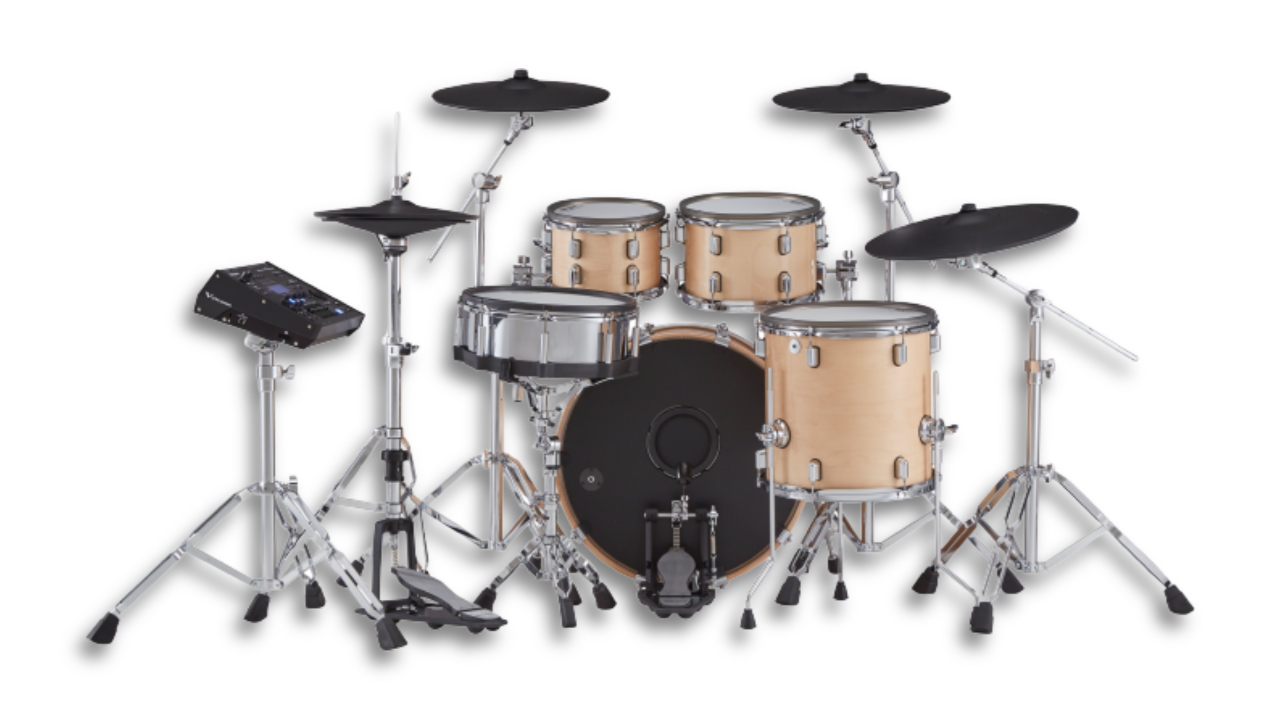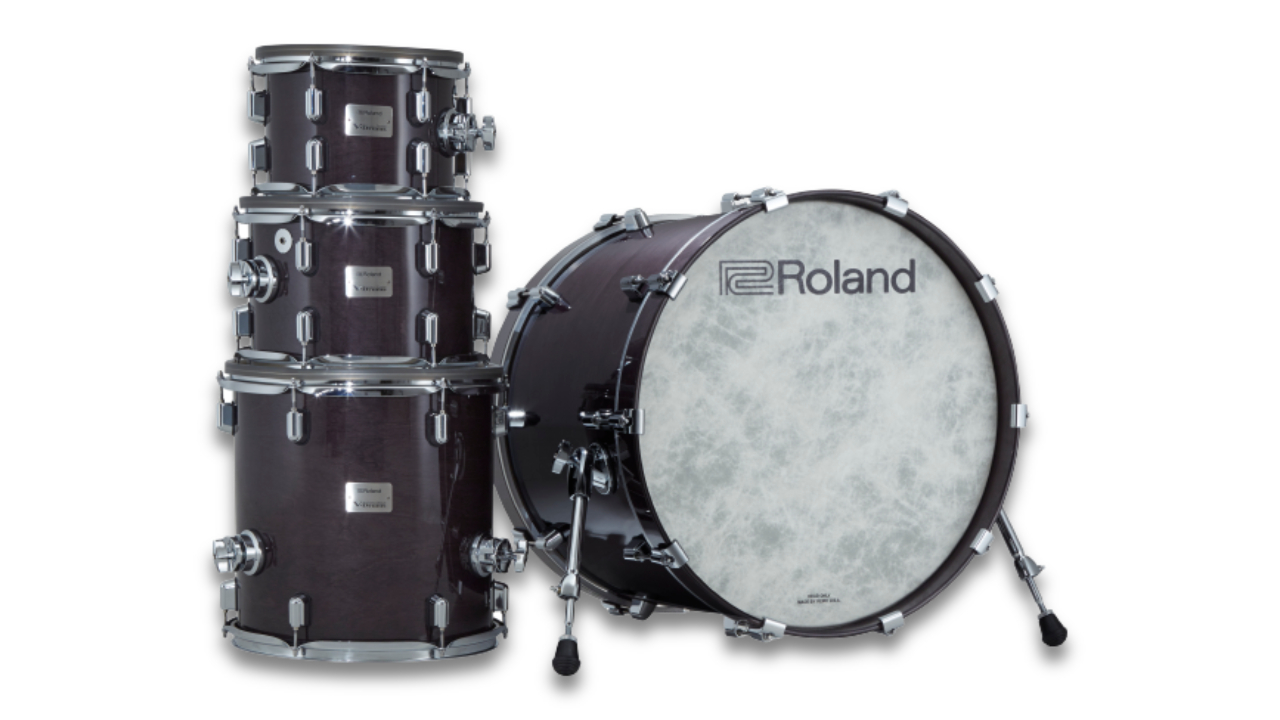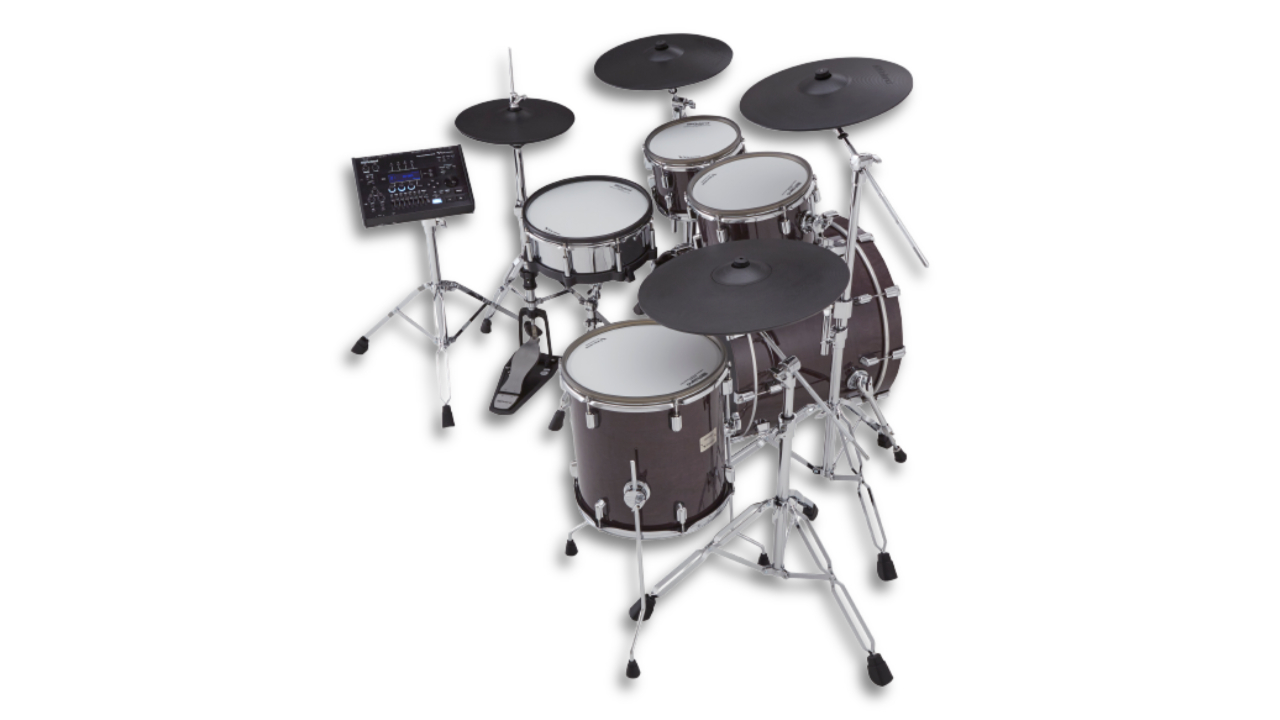MusicRadar Verdict
The big draw with the VAD706 is the overall playing experience. The size of the kit, the positional sensing where it’s needed most, and those new VH-14D hi-hats really combine with the sounds on offer from the TD-50X module to reduce the gap between electronic and acoustic mindsets, bringing both worlds closer together.
Pros
- +
The most realistic feel currently available
- +
Advanced digital triggering
- +
Hugely flexible module
Cons
- -
It’s extremely expensive
MusicRadar's got your back
Roland VAD706 review: What is it?
“It sounds great, but I’d never gig it”. That’s the mantra of the unconvinced acoustic drummer when presented with all of the possibilities an electronic drum set can deliver. But, in case you hadn’t noticed, there’s something in the water when it comes to electronic kits: namely, they’re starting to resemble our old faithfuls more and more.
Now, this isn’t a new thing. Hybrid acoustic/electric kits have been doing the rounds for decades with concealed triggers built into kits on some of the biggest stages in rock since the ‘80s. But there’s a big difference, and that is the reliability, realism and response that we can now achieve via electronics. Just a quick look at forums and Facebook groups over this past 18 months or so will reveal a huge boom in DIY-ers modding old shells with triggers and mesh heads in order to feel like they aren’t quite so far from normality. Indeed, the kit we’re reviewing here isn’t even Roland’s first rodeo when it comes to electro-acoustic kits. The VAD series launched in 2018, and it seems the drum industry has been moving as one in the same direction, with similar offerings from Pearl, GEWA, ATV, even acoustic shell obsessives, DW.
But now, Roland has released the VAD706: its flagship vision for how this concept should be. It starts with full-size shells (22”, 10”, 12”, 14” and a 14” snare), however this is far from just a re-hashed version of the already-released VAD series drums. There’s a brand new module in the shape of the TD-50X and a brand new VH-14D digital hi-hat pad - the first to make use of Roland’s digital sensing, offering an enhanced resolution of open/closed sounds as well as strike position.
These new additions are met by the digital sensing of the Roland PD-140DS and CY18-DR, meaning that the (arguably) most dynamic parts of the kit are all now benefiting from Roland’s enhanced intelligence, which we’re hoping should add-up to even more of that all-important realism.
Roland VAD706 review: The module

The VAD706 has a lot to unpack, both physically and metaphorically. So first, what’s new with that module? The TD-50X obviously shares most of its name with Roland’s most recent flagship module, and as such makes the familiar TD-50 wheel turn faster, rather than reinventing it.
The module itself has been given a very slight facelift, with all the same controls and switches present, just tweaked a bit. It’s a similar story at the back of the module, with the same sockets present and correct: MIDI in/out, 8 direct outs, two pairs of master outputs, a mix input and 14 trigger inputs. Most notably, the TD-50X includes the same three digital trigger inputs as-per the original design, nodding to the fact that Roland has had the final instalment of its digital trilogy up its sleeve since the TD-50 came to market. And there was us thinking it was an attempt at getting triple-ride-toting jazzers to convert to electronic!
Nope, the developments here relate to function and sound. First, Roland has added just shy of 500 studio-quality sounds to the X-version, alongside 70 new kit presets, all of which make use of its Prismatic sound modelling engine and are fully optimised (along with the existing sounds and kits) to get the best out of the new VH-14D hi-hat. As well as this, the TD-50X functions as a 32-channel USB audio interface (the 50 only managed 10). They’ve upgraded the effects, too, adding in PureAcoustic Ambience to help you place the kits in virtual studio and performance environments, and finally, you can expand the soundset via Roland Cloud, making the TD-50X the first V-Drums product able to do so.
Want all the hottest music and gear news, reviews, deals, features and more, direct to your inbox? Sign up here.
If you’re a TD-50 owner currently steaming up your screen with anger, then settle down. Roland has made all of these features available for the original TD-50 for a one-off cost of $199, and we think it’s worth it.
The existing and additional sounds contained within the module are impressive - all electronic drum companies have a massive fight on their hands when it comes to rivalling even budget software sample packs, and more importantly, producing hardware that’s capable of delivering them without latency.
Roland has managed it with a lot of the TD-50X sounds, finally stepping out from ‘good for built-in’ to impressive, regardless. There’s a decent range of multi-layered samples housed within, and while it’s moot for us to choose our favourites, the snare and cymbal selection in particular offers plenty of variation. That’s before you start editing or applying the PureAcoustic Ambience (which works via a blend of real room ambient mic samples and digital reverb). You can import your own, too, but the real story here lives away from preset sounds - it’s about the overall experience.
Roland VAD706 review: Performance & verdict

Can you feel it?
Our review kit was supplied in the Natural maple finish. The shells arrived fully-fitted with their mesh heads, and they mount to the included dual cymbal/tom stands with ease. It’s a good first sign when you feel like you’re setting-up an acoustic drum kit.
It would have been very simple for an electronic drum brand to overlook the visual element of the shells themselves, after all, they are - fundamentally - housings for the business going on under the hood. But instead of cheap-looking solid wraps, we get maple grain and lacquered finishes. Sure, they’re not cut from exotic burls or rare species, but they do look and feel like drums when you pick them up. Not overstated, nor are they bland, just realistic thanks to the fact that these are designed and built by actual drum makers.
It’s a good first sign when you feel like you’re setting-up an acoustic drum kit.
The shells attach to the module via discrete jack cables - no bespoke snake here - which is great if you need to replace a single cable, or want to customise them with cables of your choice. The digital pads, meanwhile, use a USB connection, which includes its own stress-protector housing for connecting to the shorter breakout cables that are hardwired into the digital pads. It all locks in place and feels secure for life on the road.
One major benefit of an acoustic-style electronic setup is the size and placement of the ‘pads’. Often when using slim pads attached to a frame, there’s a sense of ‘transferring’ to our digital kits. The frame height can mean sitting lower, the pad depths make for an un-realistically close positioning, both in terms of their height and proximity to each other, all of which adds up to making things a lot more compact, easier to navigate at speed and a bit of a shock when you eventually sit behind an acoustic kit again. With the VAD sets, this is instantly eradicated, and whether it’s the VAD706 or the more streamlined VAD503, the advantage of a more traditional placement has a big impact on the way you approach your playing.

But it’s not all about geography, the thing you’re hitting needs to feel realistic too. Roland has led the way with mesh heads, and it’s no different in this scenario. The dual-ply heads are well known as a Roland patent, and while the feel isn’t a million miles from what you’ll be used to from any one of Roland’s mesh-equipped pads, it’s the floor tom and snare that really stand out. The tension (or lack of it) available across the larger surface areas makes everything feel a little more like we’re sat behind an acoustic kit, and combined with the tune-able nature of the surface, plus the placement, you really do feel closer than ever to ‘home’.
This extends to the bass drum too. If you’re used to playing an electronic bass drum tower - as stable as they can be - it’s a world apart. The shell is obviously a bass drum, measuring 22”x18” and with the weight and stability to match, but your striking surface is essentially the Roland KD-A22 acoustic conversion kit. It comprises a pad mounted into the head, but Roland has designed it to maintain the movement of air inside the shell. Ours came pre-mounted, and we found that we needed to rotate the head a little in order to properly accommodate both beaters of our double pedal; but once you have it set, it’s remarkably like the real thing - no wobbling, no creep.
Electric dreams
Of course, one of the key benefits of the VAD series, and in particular the TD-50X-equipped VAD706, is the integration of digital triggering. If you aren’t aware, the digital snare, ride, and now hi-hats offer a far greater level of sophistication when it comes to triggering. Each features multiple sensors and processors to handle the uplift in information being produced by the pad.
The PD-140DS, for example, has the usual head/rim sensors, but adds an additional three position sensors on the head, and three more for the cross-stick. But what does this add up to in terms of sound production? Well, you can seamlessly transition between edge and centre, with dedicated samples reflecting this movement. You can play a centre hit, rimshot, cross-stick - including stick depth and tonality - without any manual switching, and you can even use brushes in a traditional playing style. It’s addictive, and we found ourselves spending a lot longer than we should have executing buzz rolls from the edge to the centre trying to trip it up, while basking in the dynamics on offer. We did experience a few miss-fired hits while playing cross-sticks, but thankfully there are plenty of settings on hand for fine-tuning the interaction between zones.

It’s a similar story with the CY-18DR ride cymbal, with three sensors in the bow, plus a bell, edge and touch sensor. Depending on the type of music you’re playing, you’ll appreciate the added dynamics here, but we’d say it’s a more subtle advantage when compared to the snare for most rock playing.
The big news is the VH-14D hi-hats. As with the VH-13 hats, these are a two-piece design, mounted on a traditional hi-hat stand. But the experience is quite different. First, they’re 14 inches in diameter, matching the size of most common acoustic hi-hats. Next, they also make use of Roland’s digital sensing tech to give you velocity; three sensors on the bow and edge sensor, motion sensor, and a hand-chokable touch sensor. As mentioned already, the VH-14D includes its own processor to take the heavy lifting away from the module. There’s a lot going on, but it’s the open/closed positions where you’ll notice the added resolution. We calibrated our review hats using the TD-50X’s setup wizard to set the feel from our stand, and it’s that simple - no jumping between positions, no misfiring, the VH-14D just reacts as we want them to, and given their realistic size and performance, we’d say that these are the missing link that you didn’t realise you needed.
Conclusion
So far, we’ve had a thoroughly nice time playing on a premium electronic drum set, but we’ve overlooked the elephant so massive that it’s not only in the room, it’s taking over the whole house: price. The VAD706 costs a fortune, and there’s no escaping that. At £7,000, this is likely to cost more than many single items - and certainly our tricked-out dream kit - that most of us own.
But, this isn’t supposed to be budget. This kit is designed to show what’s possible from the biggest name in digital drums. And the result is a hell of a lot.
It’s an expensive kit with the latest tech aimed at making its way onto the world’s biggest stages.
The big draws with the VAD706 are the overall playing experience. As we’ve already mentioned, the size of the kit, the positional sensing where it’s needed most, and those new VH-14D hi-hats really combine with the sounds on offer from the TD-50X to reduce the gap between electronic and acoustic mindsets, bringing both worlds closer together.
That said, there will still be a number of players who may only ever use this as a very expensive MIDI controller, and the physical experience is that good that we wouldn’t blame them. We’d love to see this offered as a more ‘dumb’ configuration with a straight trigger to MIDI converter module.
Conceptually, it’s an absolute game-changer, and if we could all have one, we absolutely would. If you don’t have the cash, you’re not entirely left out of the game - you will need at least a Roland TD-27 module to make use of the digital sensing - but Roland produces its VAD503 and 506 kits, albeit without the VH-14D hi-hats as standard. But if you want the full-size, full-fat VAD experience, the VAD706 delivers, even if you need to save for it.
Roland VAD706 review: Hands-on demos
Sweetwater
Roland
Better Music
Roland VAD706 review: Specifications
- Module: Roland TD-50X
- Pads: KD-222 (bass drum), PDA100, PDA120, PDA140F (toms) PD-140DS (digital snare), VH-14D (digital hi-hats), CY-18DR (digital ride), CY-16R-T (crashes, x2)
- Hardware: Roland DTS-30S set (2x cymbal/tom stands, 1x module stand, 1x cymbal stand)
- Connections: MIDI in/out, TRS trigger inputs x14, 3x digital trigger inputs, Master L/R out x2, USB audio/data, direct outputs x8, mix input, SD card slot
- Audio interface: Yes, 32-channel
- Contact: Roland

Stuart has been working for guitar publications since 2008, beginning his career as Reviews Editor for Total Guitar before becoming Editor for six years. During this time, he and the team brought the magazine into the modern age with digital editions, a Youtube channel and the Apple chart-bothering Total Guitar Podcast. Stuart has also served as a freelance writer for Guitar World, Guitarist and MusicRadar reviewing hundreds of products spanning everything from acoustic guitars to valve amps, modelers and plugins. When not spouting his opinions on the best new gear, Stuart has been reminded on many occasions that the 'never meet your heroes' rule is entirely wrong, clocking-up interviews with the likes of Eddie Van Halen, Foo Fighters, Green Day and many, many more.
